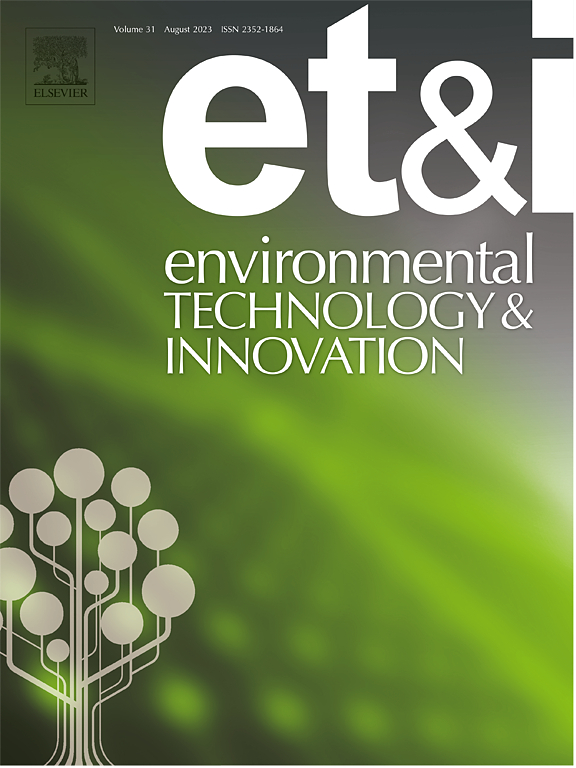Electrokinetic transport mechanisms of rare earth elements in ion-adsorption deposits: An integrated model approach
IF 6.7
2区 环境科学与生态学
Q1 BIOTECHNOLOGY & APPLIED MICROBIOLOGY
引用次数: 0
Abstract
Heavy rare earth elements (REEs) are critical strategic resources for advanced technologies and the low-carbon economy transition. Ion-adsorption deposits (IADs) represent the primary sources of heavy REEs, yet their mining has caused severe environmental impacts. Electrokinetic mining (EKM), a sustainable alternative, promises efficient REE recovery from IADs. However, the electrokinetic transport mechanisms of REEs in IADs remain unclear, and predictive models are lacking. Here, we develop an integrated EKM (IEKM) model that rigorously incorporates coupled effects of diffusion, convection, electromigration, electroosmosis, and electrolysis to resolve REE transport in IADs. The IEKM model was validated using a 14-ton-scale IAD EKM, accurately simulating REE and leaching agent (NH₄⁺) ion transport. The predicted REE recovery efficiency is 80.97 % after 11 days of EKM, aligning with experimental results (88.28 ± 17.00 %). Significantly, the IEKM model quantitatively determines that diffusion, convection, electromigration, electroosmosis, and electrolysis contribute 3.06 %, 2.90 %, 82.91 %, 0.20 %, and 10.93 %, respectively, to REE transport. Unexpectedly, electromigration emerges as the dominant mechanism governing REE electrokinetic transport in IADs with significant influence by electrolysis, while electroosmosis exhibits negligible contribution, contradicting conventional expectations. Furthermore, electrolysis consumed 57.95 % of input energy due to water splitting, leaving only 42.05 % for direct REE transport. This work advances fundamental understanding of REE electrokinetic transport in IADs and establishes an industrially viable model, bridging experimental and numerical modeling to facilitate practical applications of environmentally sustainable EKM technology in resource recovery.
离子吸附矿床中稀土元素的电动力学输运机制:一个综合模型方法
重稀土元素是实现先进技术和低碳经济转型的重要战略资源。离子吸附矿床是重稀土元素的主要来源,其开采造成了严重的环境影响。电动采矿(EKM)是一种可持续的替代方案,有望有效地从iad中回收稀土元素。然而,稀土元素在IADs中的电动力学运输机制尚不清楚,也缺乏预测模型。在这里,我们开发了一个集成的EKM (IEKM)模型,该模型严格纳入了扩散、对流、电迁移、电渗透和电解的耦合效应,以解决稀土在IADs中的迁移。使用14吨规模的IAD EKM验证了IEKM模型,准确模拟了REE和浸出剂(NH₄⁺)离子的传输。EKM处理11 d后稀土元素的预测采收率为80.97 %,与实验结果(88.28 ± 17.00 %)吻合。值得注意的是,IEKM模型定量地确定了扩散、对流、电迁移、电渗透和电解对稀土输运的贡献分别为3.06 %、2.90 %、82.91 %、0.20 %和10.93 %。出乎意料的是,电迁移成为IADs中稀土电动力学运输的主要机制,受到电解的显著影响,而电渗透的贡献可以忽略不计,这与传统的预期相矛盾。此外,电解消耗了57.95 %的水分裂输入能量,只剩下42.05 %的REE直接运输。这项工作推进了对稀土在IADs中的电动运输的基本理解,并建立了一个工业上可行的模型,将实验和数值模拟联系起来,以促进环境可持续的EKM技术在资源回收中的实际应用。
本文章由计算机程序翻译,如有差异,请以英文原文为准。
求助全文
约1分钟内获得全文
求助全文
来源期刊

Environmental Technology & Innovation
Environmental Science-General Environmental Science
CiteScore
14.00
自引率
4.20%
发文量
435
审稿时长
74 days
期刊介绍:
Environmental Technology & Innovation adopts a challenge-oriented approach to solutions by integrating natural sciences to promote a sustainable future. The journal aims to foster the creation and development of innovative products, technologies, and ideas that enhance the environment, with impacts across soil, air, water, and food in rural and urban areas.
As a platform for disseminating scientific evidence for environmental protection and sustainable development, the journal emphasizes fundamental science, methodologies, tools, techniques, and policy considerations. It emphasizes the importance of science and technology in environmental benefits, including smarter, cleaner technologies for environmental protection, more efficient resource processing methods, and the evidence supporting their effectiveness.
 求助内容:
求助内容: 应助结果提醒方式:
应助结果提醒方式:


